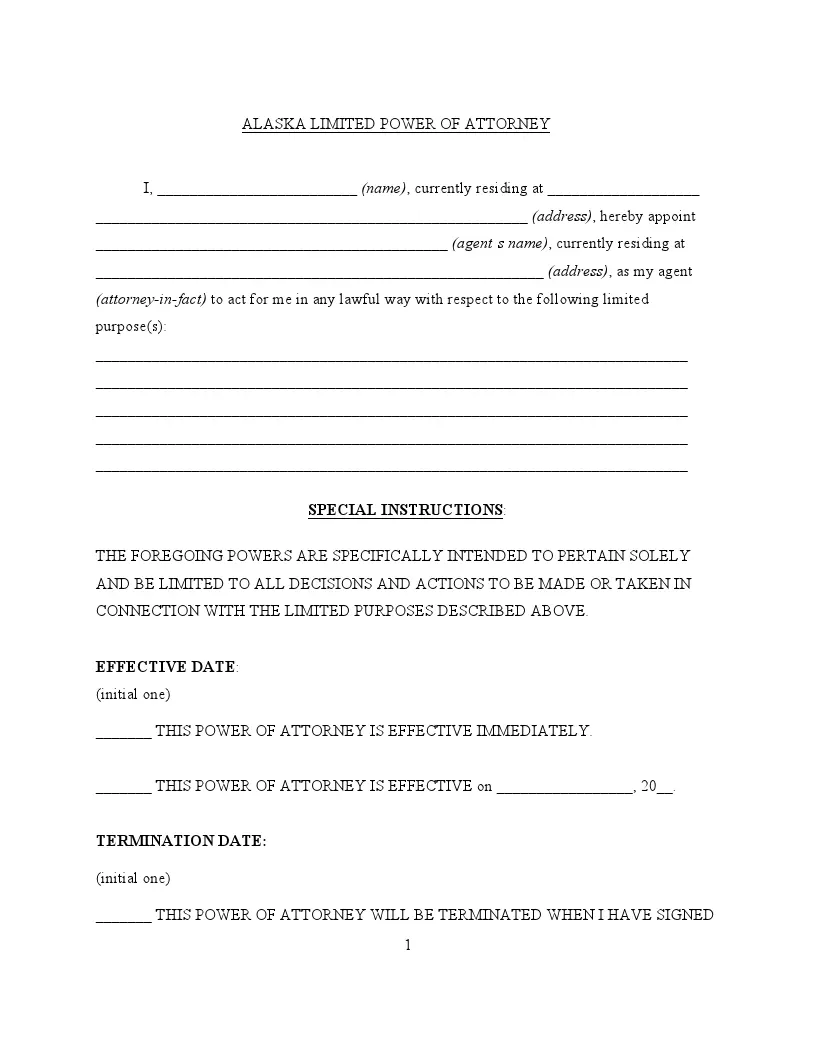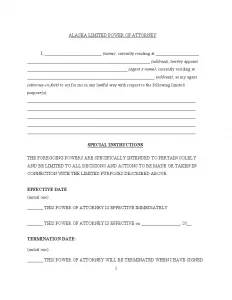Alaska Limited Power of Attorney Form
The Alaska limited power of attorney is a legal form that allows a person, known as the “principal,” to designate the “agent” or “attorney-in-fact,” to perform specific actions or make decisions on their behalf. This form is “limited” because it restricts the agent’s powers to a particular activity or set of activities, unlike a general power of attorney, which grants broader authority.
For example, a limited power of attorney may authorize the agent to manage the sale of a property or handle financial transactions, but only under certain circumstances or for a defined period. The principal can tailor the powers granted to fit specific needs, ensuring the agent has just enough authority to perform the required tasks without granting excessive control over all affairs. This document is particularly useful for situations where the principal cannot be present to perform necessary duties, such as during travel or illness.
Get all the available Alaska power of attorney forms — fill out the state-specific templates you need.

Build Your Document
Answer a few simple questions to make your document in minutes
Save and Print
Save progress and finish on any device, download and print anytime
Sign and Use
Your valid, lawyer-approved document is ready
In Alaska, the laws governing the signing requirements for a limited power of attorney are stipulated under Alaska Statutes — Title 13, Chapter 26, Article 5. These regulations ensure that such legal documents are executed properly and recognized as valid and binding.
A limited power of attorney in Alaska must be signed by the principal — the person granting the authority. However, the presence of the principal’s signature alone is not sufficient. According to Alaska Statute § 13.26.600, the signing of a power of attorney must be witnessed and authenticated by a notary public. Here are the steps involved in the process:
- The principal must sign the form.
- The notary public must witness the signing.
- A notarial seal must be placed on the form to verify its authenticity.
A notary public’s involvement helps prevent fraud and ensures that the principal signs the document willingly and without duress. Under Alaska Statute § 13.26.625, a power of attorney remains in effect and binding until the agent is aware of the principal’s death or incapacity, allowing actions taken in good faith to legally bind the principal and their successors.
Alaska Limited Power of Attorney Form Details
| Document Name | Alaska Limited Power of Attorney Form |
| Other Name | Alaska Special Power of Attorney |
| Relevant Laws | Alaska Statutes, Sections 13.26.600 to 13.26.695 |
| Avg. Time to Fill Out | 8 minutes |
| # of Fillable Fields | 32 |
| Available Formats | Adobe PDF |
Filling Out Alaska Limited POA
Filling out an Alaska limited power of attorney involves providing specific information about the principal, the attorney-in-fact, and the scope of authority granted. This guide will walk you through the steps to complete this form correctly.
1. Enter the Principal’s Full Name and Social Security Number
Start by writing your full name (as the principal) and your social security number in the designated spaces at the beginning of the form.
2. Assign an Attorney-in-Fact
Enter the full name and address of the person you designate as your attorney-in-fact. This individual will have the authority to act on your behalf in the capacities you specify.
3. Define the Powers Granted
Clearly describe the specific powers you are granting to your attorney-in-fact. Be as detailed as possible to avoid any ambiguity regarding their authority.
4. Acknowledge Fiduciary Agreement
Confirm that your attorney-in-fact agrees to accept this appointment and will act in your best interest, adhering to the terms outlined in the document.
5. Sign and Date the Form
Sign the form and write the date you are executing this power of attorney. This act formalizes the document and indicates your intent for it to take effect immediately or as specified.
6. Notarization
Have the document notarized. This will involve signing the form before a notary public on the specified date. The notary will verify your identity and acknowledge that you are signing the document willingly and under no duress.
